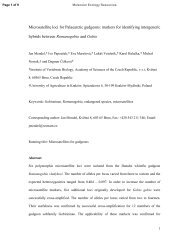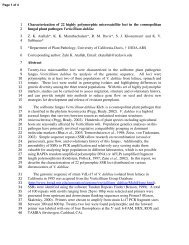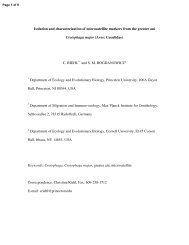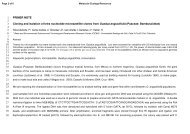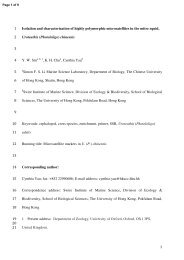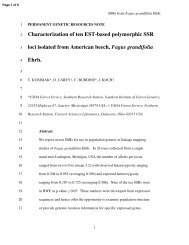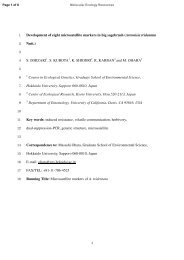Novel polymorphic microsatellites useful for population analysis in ...
Novel polymorphic microsatellites useful for population analysis in ...
Novel polymorphic microsatellites useful for population analysis in ...
You also want an ePaper? Increase the reach of your titles
YUMPU automatically turns print PDFs into web optimized ePapers that Google loves.
Page 1 of 10<br />
Molecular Ecology Resources<br />
1<br />
2<br />
<strong>Novel</strong> <strong>polymorphic</strong> <strong>microsatellites</strong> <strong>useful</strong> <strong>for</strong> <strong>population</strong><br />
<strong>analysis</strong> <strong>in</strong> Meretrix meretrix (Bivalva: Veneroidae)<br />
3<br />
4<br />
Shu-Y<strong>in</strong> Chen*†, Lei. Wang*, Wen. Sun*, Hong-Jiu Ji†, Xiao-Feng Xu* 1<br />
5<br />
6<br />
7<br />
8<br />
*Jiangsu Key Laboratory <strong>for</strong> Biodiversity and Biotechnology, College of Life Sciences,<br />
Nanj<strong>in</strong>g Normal University, Nanj<strong>in</strong>g 210097, Ch<strong>in</strong>a; †Jiangsu Mar<strong>in</strong>e Fisheries<br />
Research Institute, Nantong 226007, Ch<strong>in</strong>a<br />
9<br />
10<br />
11<br />
12<br />
13<br />
14<br />
15<br />
16<br />
17<br />
18<br />
19<br />
Abstract<br />
The asiatic hard clam Meretrix meretrix is one of the largest species <strong>in</strong> size among<br />
the Venus-shells (Veneridae). It is of great commercial value throughout Ch<strong>in</strong>a,<br />
however little is known of the genetic diversity or structure of its wild <strong>population</strong>s. In<br />
order to evaluate its genetic diversity, we have isolated eleven <strong>polymorphic</strong><br />
microsatellite DNA loci from M. meretrix <strong>in</strong> this study. The numbers of alleles<br />
observed <strong>for</strong> a s<strong>in</strong>gle locus ranged from four to 16 per locus, with <strong>polymorphic</strong><br />
<strong>in</strong><strong>for</strong>mation content from 0.420 to 0.808. These genetic markers will be valuable<br />
tools <strong>for</strong> genetic diversity studies of both cultivated and wild <strong>population</strong>s of M.<br />
meretrix.<br />
20<br />
21<br />
Keywords: Meretrix meretrix, microsatellite locus, polymorphism, bivalve<br />
Correspondence: X.F. XU, E-mail: xuxiaofeng@njnu.edu.cn, Fax: +86-25-85891513.<br />
1
Molecular Ecology Resources<br />
Page 2 of 10<br />
22<br />
23<br />
24<br />
25<br />
26<br />
27<br />
28<br />
29<br />
30<br />
31<br />
32<br />
33<br />
34<br />
35<br />
36<br />
37<br />
38<br />
39<br />
40<br />
41<br />
42<br />
The asiatic hard clam Meretrix meretrix (L<strong>in</strong>naeus), found <strong>in</strong> sandy-mud habitats from<br />
the <strong>in</strong>tertidal zone to 6 m depth, is one of the largest species <strong>in</strong> size among the<br />
Venus-shells (Veneridae) and an endemic along the coasts of Ch<strong>in</strong>a (Wang et al.1998).<br />
This species is of great value and commercial importance <strong>in</strong> Asia, and has been widely<br />
cultured <strong>in</strong> Ch<strong>in</strong>a. Moreover, this clam, proclaimed the ‘number one delicacy on earth’<br />
by Qianlong (emperor of the Q<strong>in</strong>g Dynasty), is a very popular seafood throughout<br />
Ch<strong>in</strong>a. Be<strong>in</strong>g such an encouraged farm<strong>in</strong>g species, a number of previous research<br />
studies of asiatic hard clam were mostly focused on reproductive biology and culture<br />
technology (Zhang et al. 2005; Wang et al. 2006). However, the clam farm<strong>in</strong>g is<br />
dependant on natural stocks and clam famers often purchase a large number of wild<br />
juvenile clams and transport them from one place to another <strong>for</strong> commercial cultivation.<br />
This method of immigration might result <strong>in</strong> new genetic variants to the established gene<br />
pool. Genetic diversity study could provide <strong>useful</strong> <strong>in</strong><strong>for</strong>mation <strong>for</strong> conservation of<br />
natural stocks and selective breed<strong>in</strong>g of M. meretrix. For example, the identification of<br />
genetically dist<strong>in</strong>ct <strong>population</strong>s of M. meretrix (e.g., Chen et al. 2004; Du et al. 2004;<br />
Cheng et al. 2007) and the <strong>analysis</strong> of artificially cultured and wild <strong>population</strong>s of this<br />
clam (He et al. 2008) are of high value to the evaluation of genetic diversity <strong>in</strong> this<br />
species.<br />
Microsatellites are evenly dispersed throughout genomes. High polymorphism and<br />
relative ease of scor<strong>in</strong>g represent two major features that make <strong>microsatellites</strong> <strong>useful</strong> <strong>for</strong><br />
2
Page 3 of 10<br />
Molecular Ecology Resources<br />
43<br />
44<br />
45<br />
46<br />
47<br />
48<br />
49<br />
50<br />
51<br />
52<br />
53<br />
54<br />
55<br />
56<br />
57<br />
many genetic studies (Zane et al. 2002). Microsatellites have become very <strong>useful</strong><br />
markers <strong>for</strong> the research of genetic diversity, pedigree trac<strong>in</strong>g and quantitative trait loci<br />
(QTL). No microsatellite markers have so far been reported <strong>for</strong> M. meretrix. To assist<br />
genetic studies <strong>in</strong> this species, here we report the characterization of eleven<br />
<strong>polymorphic</strong> microsatellite loci of M. meretrix, and evaluate the use of these loci to<br />
quantify the genetic diversity of a wild <strong>population</strong>.<br />
Genomic DNA was extracted from the adductor muscle of one <strong>in</strong>dividual us<strong>in</strong>g the<br />
DNeasy Tissue Kit (Qiagen) accord<strong>in</strong>g to the manufacturer’s protocol. The DNA was<br />
then subjected to restriction digestion with Mse I (NEB), and simultaneously ligated to<br />
adaptors: oligo 1: 5′-TAC TCA GGA CTC AT-3′ and Oligo 2: 5′-GAC GAT GAG TCC<br />
TGA G-3′ at 37 °C <strong>for</strong> 4 h. The ligated fragments were amplified by PCR us<strong>in</strong>g the<br />
Mse-N (5′-GAT GAG TCC TGA GTA AN-3′) as a primer, and the amplification<br />
condition was per<strong>for</strong>med by 23 cycles of 40 s at 94 °C, 50 s at the anneal<strong>in</strong>g 53 °C and<br />
30 s at 72 °C, with a f<strong>in</strong>al extension time of 5 m<strong>in</strong> at 72 °C. PCR products were selected<br />
rang<strong>in</strong>g from 300-800 bp accord<strong>in</strong>g to a DNA standard marker and hybridized to two 5′<br />
58<br />
biot<strong>in</strong>ylated probe (CA) 15 and (GA) 15<br />
at room temperature <strong>for</strong> 30 m<strong>in</strong>. The hybridized<br />
59<br />
60<br />
61<br />
62<br />
63<br />
fragments were captured by streptavid<strong>in</strong>-coated magnetic beads (Promega),<br />
unhybridized DNA was washed away and the rema<strong>in</strong><strong>in</strong>g DNA was eluted from the<br />
beads. The eluted fragments were amplified aga<strong>in</strong> with the same PCR reaction<br />
conditions as mentioned above, and the products were f<strong>in</strong>ally purified. The purified<br />
DNA were cloned <strong>in</strong>to pGEM-T Easy vectors (Promega) at 4 °C overnight, and then<br />
3
Molecular Ecology Resources<br />
Page 4 of 10<br />
64<br />
65<br />
66<br />
67<br />
68<br />
69<br />
70<br />
71<br />
72<br />
73<br />
74<br />
75<br />
76<br />
77<br />
78<br />
79<br />
80<br />
81<br />
82<br />
83<br />
84<br />
trans<strong>for</strong>med <strong>in</strong>to JM109 competent cells. Trans<strong>for</strong>med cells grew at 37 °C <strong>for</strong> 16 h on<br />
an LB agar plate conta<strong>in</strong><strong>in</strong>g ampicill<strong>in</strong> (100 mg/mL), X-gal and IPTG <strong>for</strong> blue/white<br />
selection.<br />
A total of 67 clones were sequenced and 56 conta<strong>in</strong>ed <strong>microsatellites</strong> with over five<br />
repeats. Sixteen primer sets were designed us<strong>in</strong>g PRIMER 3 (Rozen & Skaletsky 2000)<br />
and synthesized (Invitrogen). The <strong>for</strong>ward primer of each set primers was synthesized<br />
with a modified 19 bp M13 tail (f-29: 5′-CACGACGTTGTAAAACGAC-3′) ( LI-COR)<br />
added to the 5′-end. The PCR amplifications were optimized us<strong>in</strong>g a PTC-200<br />
Thermocycler (MJ Research) and per<strong>for</strong>med <strong>in</strong> a 20 µL reation mixture, <strong>in</strong>clud<strong>in</strong>g 10<br />
µL Ex Taq DNA polymerase premix buffer (Takara) , and about 50 ng of DNA template,<br />
0.8 µM of each primer, and 0.5 pmol of fluorescent labeled primer (IRDye700 or<br />
IRDye800) (LI-COR). The conditions <strong>for</strong> amplification were 8 m<strong>in</strong> at 94 °C followed<br />
by 34 cycles of 94 °C <strong>for</strong> 40 s, 50 s at the anneal<strong>in</strong>g temperature (Table 1) and 72 °C <strong>for</strong><br />
30 s, and f<strong>in</strong>ally followed by 8 m<strong>in</strong> at 72 °C. PCR products were electrophoresed on<br />
6.5% polyacrylamide gels us<strong>in</strong>g a LI-COR 4300 DNA analyzer. Allele sizes were<br />
determ<strong>in</strong>ed by comparison to a standard size ladder (LI-COR) and then analyzed us<strong>in</strong>g<br />
LI-COR SAGA GT software.<br />
Allelic variation at each microsatellite locus was assessed by genotyp<strong>in</strong>g 28<br />
specimens, which were collected from the coastal area of Qidong (QD, E121°36′,<br />
N32°10′), Jiangsu prov<strong>in</strong>ce, Ch<strong>in</strong>a. Genomic DNA was extracted with a genomic DNA<br />
kit (Axygen). Eleven of the 16 microsatellite loci were <strong>polymorphic</strong>. The alleles number<br />
4
Page 5 of 10<br />
Molecular Ecology Resources<br />
85<br />
86<br />
87<br />
88<br />
89<br />
90<br />
91<br />
92<br />
93<br />
94<br />
95<br />
96<br />
97<br />
98<br />
99<br />
100<br />
101<br />
102<br />
103<br />
104<br />
105<br />
(N A ) at each <strong>polymorphic</strong> locus, <strong>polymorphic</strong> <strong>in</strong><strong>for</strong>mation content (PIC) and observed<br />
and expected heterozygosities at each <strong>polymorphic</strong> locus were calculated us<strong>in</strong>g<br />
CERVUS 2.0 software (Marshall et al. 1998). The observed heterozygosities (H O ) were<br />
between 0.154 and 0.773 (Table 1). N<strong>in</strong>e of the eleven loci were highly <strong>polymorphic</strong><br />
(PIC > 0.5). GENEPOP 3.4 software (Raymond & Rousset 2004) was used to test both<br />
Hardy-We<strong>in</strong>berg equilibrium (HWE) and l<strong>in</strong>kage disequilibrium (LD). Four loci were<br />
found to depart from HWE and LD was not identified between any pairs of loci (P<br />
>0.05). We used MICROCHECKER software (van Oosterhout et al. 2004) to check<br />
microsatellite data <strong>for</strong> null alleles and scor<strong>in</strong>g errors. Analysis of the microsatellite<br />
dataset <strong>in</strong>dicated significant deficits of heterozygotes present at the four loci that were<br />
out of HWE, and the most probable cause of these were null alleles. From the results of<br />
previous studies on bivalve, e.g., zebra mussel Dreissena polymorpha (Astanei et al.<br />
2005), pacific oyster Crassostrea gigas (Hedgecock et al. 2004), eastern oyster C.<br />
virg<strong>in</strong>ica (Reece et al. 2004; Carlsson et al. 2006), and bay scallop Argopecten<br />
irraidians (Zhan et al. 2007), null alleles also seem to be a explanation <strong>for</strong> heterozygote<br />
deficiencies. In addition, multiple pairwise comparisons were determ<strong>in</strong>ed us<strong>in</strong>g the<br />
sequential Bonferroni method (Rice, 1989). After the correction, departures from HWE<br />
was observed only <strong>in</strong> WG604 (P < 0.05/11).<br />
The result obta<strong>in</strong>ed <strong>in</strong> this study revealed that most of the <strong>microsatellites</strong> developed<br />
here are highly <strong>polymorphic</strong>, and the genetic diversity of wild <strong>population</strong> was at high<br />
levels accord<strong>in</strong>g to the PIC. This <strong>in</strong><strong>for</strong>mation will be essential to acquaculture<br />
5
Molecular Ecology Resources<br />
Page 6 of 10<br />
106<br />
107<br />
108<br />
109<br />
development and management of genetic resources of M. meretrix. The <strong>microsatellites</strong><br />
should be <strong>useful</strong> tools <strong>for</strong> a better understand<strong>in</strong>g of genetic <strong>population</strong> structure <strong>in</strong> the<br />
wild, the conservation and ma<strong>in</strong>tenance of wild <strong>population</strong>s as well as aid<strong>in</strong>g <strong>in</strong><br />
management of genetic breed<strong>in</strong>g programs.<br />
6
Page 7 of 10<br />
Molecular Ecology Resources<br />
110<br />
111<br />
112<br />
Table 1 Characteristics of the eleven <strong>polymorphic</strong> microsatellite loci isolated from Meretrix meretrix.<br />
Locus Accession no. Repeat motif Primer sequence (5′−3′) Size(bp) Ta(°C) N A H O H E PIC<br />
WG307 FJ232978 (CA) 17 F: AGCTACGCTATACTCCACACTC 182-220 58 8 0.741 0.843 0.808<br />
R: GGACCAGACACAATGTATAAACT<br />
WG312 FJ232979 (TG) 8 F: GTCACAGGGACTCAAAGAT 239-281 58 7 0.571* 0.790 0.747<br />
R: ATCAAAATAGAATAACTAGATGT<br />
WG323 FJ232980 (GT) 27 F: GCCATAACAGTCCTACAAACGG 214-262 60 7 0.621* 0.842 0.805<br />
R: CGATCAATGATAGGCGTTCAAAG<br />
WG335 FJ232981 (CA) 17 F: ATAACTCTCCCACTCTAAAACTC 214-240 52 10 0.679 0.829 0.790<br />
R: TAGAATGGGAGCATGTGATAG<br />
WG337 FJ232982 (GT) 35 F: TCATGGCATTGTTTTAGAAGG 134-212 52 12 0.517* 0.764 0.730<br />
R: TTTATCGTTGTGATTGACAGTTC<br />
WG347 FJ232983 (GCGT) 8 (GT) 25 F: GTGATTCCAATATAGCTTCCCC 206-216 58 4 0.321 0.486 0.420<br />
R: GCACATAGGCAAACAATAGACAG<br />
WG604 FJ232984 (TC) 8 G(TC) 22 F: TTATAGGTCACCGCCATTTACTG 309-329 58 6 0.154* 0.837 0.783<br />
R: AATCCACATCATAGACAAACGCT<br />
WG607 FJ232985 (GA) 14 F: ATGAATCTTGAAAACTCTGGGTG 260-274 60 5 0.538 0.691 0.618<br />
R: AATCAAATGTTTCCTGGCGG<br />
WG609 FJ232986 (TACC) 7 F:TAAAGTTTGGGCAGACACTCGGT 185-247 59 8 0.621 0.569 0.531<br />
R: CGTTTCCAAGCAACAGGGCATAC<br />
WG610 FJ232987 (CT) 23 F: TCATTGCTTAGTATTGGTTGGTC 224-262 62 9 0.448 0.563 0.493<br />
R: TCGATTGCGAAACAAGTTCTAAC<br />
WG647 FJ232989 (CT) 10 F: ATTGACAATGATAATTCGGTGTG 116-336 51 16 0.773 0.835 0.805<br />
R: ACCTTGGTATGATAGTTGCGG<br />
N A is number of alleles, Ta is anneal<strong>in</strong>g temperature, H O and H E are observed and expected heterozygosities, and PIC is <strong>polymorphic</strong><br />
<strong>in</strong><strong>for</strong>mation content, asterisks denote significant deviation <strong>for</strong>m Hardy-We<strong>in</strong>berg Equilibrium (P
Molecular Ecology Resources<br />
Page 8 of 10<br />
113<br />
114<br />
115<br />
116<br />
117<br />
Acknowledgements<br />
We are grateful to Dr. Lang Chen, Dr. Zi-wei Zhang and Mr. Hui-rong Wan <strong>for</strong><br />
technical guidance and assistance <strong>in</strong> the laboratory. We are very grateful to the<br />
Subject Editor <strong>for</strong> her ef<strong>for</strong>ts <strong>in</strong> improv<strong>in</strong>g the manuscript.<br />
118<br />
119<br />
120<br />
121<br />
122<br />
123<br />
124<br />
125<br />
126<br />
127<br />
128<br />
129<br />
130<br />
131<br />
132<br />
133<br />
134<br />
References<br />
Astanei I., Gosl<strong>in</strong>g E., Wilson J. & Powell E. (2005) Genetic variability and<br />
phylogeography of the <strong>in</strong>vasive zebra mussel, Dreissena polymorpha (Pallas).<br />
Molecular Ecology, 14 (6), 1655-1666.<br />
Carlsson, Morrison & Reece (2006) Wild and aquaculture <strong>population</strong>s of the eastern<br />
oyster compared us<strong>in</strong>g <strong>microsatellites</strong>. Journal of Heredity, 97(6), 595-598.<br />
Chen D.P., Shen H.S., D<strong>in</strong>g Y.P.,Yang J.X., Shen S.D. & Xu P. (2004) Us<strong>in</strong>g<br />
<strong>in</strong>ter-simple sequence repeats(ISSR)technique <strong>in</strong> two <strong>population</strong>s of Meretrix<br />
meretrix. Journal of Nanj<strong>in</strong>g Normal University (Natural Science), 27(3), 74-77.<br />
Cheng H.L., Xia D.Q., Wu T.T., Meng X.P., Ji H.J., Dong Z.G. & Chen S.Y. (2007)<br />
Sequence <strong>analysis</strong> of mitochondrial COI gene fragment of six Veneridae clams<br />
(Mollusca : Bivalvia) and four <strong>population</strong>s of Meretrix meretrix. Acta<br />
Oceanologyca S<strong>in</strong>ica, 29(5), 109-116.<br />
Du X.D., Deng Y.W., Ye F.L. & Wang H. (2004) Genetic diversity of seven wild<br />
<strong>population</strong>s of Meretrix meretrix. Journal of Fishery Sciences of Ch<strong>in</strong>a, 11(1),<br />
41-47.<br />
8
Page 9 of 10<br />
Molecular Ecology Resources<br />
135<br />
136<br />
137<br />
138<br />
139<br />
140<br />
141<br />
142<br />
143<br />
144<br />
145<br />
146<br />
147<br />
148<br />
149<br />
150<br />
151<br />
152<br />
153<br />
154<br />
155<br />
156<br />
He C.B., Cong L.L., Ge L.L., Liu W.D., Zhou Z.C. & Gao X.G. (2008) AFLP<br />
<strong>analysis</strong> of cultured and wild hard clam (Meretrix meretrix) <strong>population</strong>s. Journal of<br />
Fishery Sciences of Ch<strong>in</strong>a, 15 (2), 215-221.<br />
Hedgecock D., Li G., Hubert S., Buckl<strong>in</strong> K. & Ribes V. (2004) Widespread null alleles<br />
and poor cross-species amplification of microsatellite DNA loci cloned from the<br />
Pacific oyster, Crassostrea gigas. Journal of Shellfish Research, 23, 379-385.<br />
Marshall T.C., Slate J., Kruuk L.E.B. & Pemberton J.M. (1998) Statistical confidence<br />
<strong>for</strong> likelihood-based paternity <strong>in</strong>ference <strong>in</strong> natural <strong>population</strong>s. Molecular Ecology,<br />
7, 639-655.<br />
Raymond M. & Rousset F. (2004) Genepop (version 3.4): <strong>population</strong> genetics<br />
software <strong>for</strong> exact tests and ecumenicism. Available at: http://wbiomed.curt<strong>in</strong>.edu.<br />
au/genepop/. html.<br />
Reece K.S., Ribeiro W.L., Gaffney P.M., Carnegie R.B. & Allen S.K. Jr (2004)<br />
Microsatellite marker development and <strong>analysis</strong> <strong>in</strong> the eastern oyster, Crossaster<br />
virg<strong>in</strong>ica: confirmation of null alleles and non-Mendelian segregat<strong>in</strong>g ratios.<br />
Journal of Heredity, 95, 255-361.<br />
Rice W.R. (1989) Analyz<strong>in</strong>g tables of statistical tests. Evolution, 43, 223-225.<br />
Rozen S. & Skaletsky H.J. (2000) Primer3 code available at http://frodo.wi.mit.edu/<br />
primer3 /primer3_code.html. In: Bio<strong>in</strong><strong>for</strong>matics Methods and Protocols: Methods<br />
<strong>in</strong> Molecular Biology (ed. by S. Krawetz & S. Misener), pp. 365-386. Humana<br />
Press, Totowa, NJ, USA.<br />
van Oosterhout C., Hutch<strong>in</strong>son W.F., Wills D.P.M. & Shipley P.F. (2004) The<br />
9
Molecular Ecology Resources<br />
Page 10 of 10<br />
157<br />
158<br />
159<br />
160<br />
161<br />
162<br />
163<br />
164<br />
165<br />
166<br />
167<br />
168<br />
169<br />
University of Hull Micro-Checker User Guide. Available at: http://www.hull.ac.uk/<br />
evolution/Software/ microchecker.html.<br />
Wang M.Z., Chen H.C. & Chen X.L. (2006) Comparison of Several Meretrix<br />
meretrix Culture Models <strong>in</strong> Ponds. Fisheries Science, 25(8), 417-419.<br />
Wang R.C., Wang Z.P. & Zhang J.Z. ( 1998) Mar<strong>in</strong>e mussel culture, pp. 318-329.<br />
Ocean University of Q<strong>in</strong>gdao Press, Q<strong>in</strong>gdao, Shandong, Ch<strong>in</strong>a.<br />
Zane L., Bargelloni L. & Patarnello T. (2002) Strategies <strong>for</strong> microsatellite isolation: a<br />
review. Molecular Ecology, 11, 1-16.<br />
Zhan A.B., Bao Z.M., Hui M.,Wang M.L., Zhao H.B., Lu W., Hu X.L. & Hu J.J.<br />
(2007) Inheritance pattern of EST-SSRs <strong>in</strong> self-fertilized larvae of the bay scallop<br />
Argopecten irradians. Annales Zoologici Fennici, 44, 259-268.<br />
Zhang A.G., Li T.W. , Su X.R. & Liu B.Z. (2005) Current Status and Prospect of<br />
Meretrix meretrix Culture. Fisheries Science, 24(2), 31-33.<br />
10




